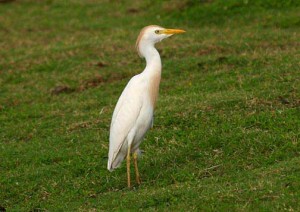Comment Deadline Approaching on Plan to Kill Egrets, Barn Owls
Next Monday is the deadline for the public to comment on an environmental study for a plan by the US Fish and Wildlife Service to “control” populations of cattle egrets and barn owls in Hawaii because of their impacts on native birds.
“Predation by cattle egrets and barn owls is currently having a direct, detrimental impact on numerous threatened or endangered species in the Hawaiian Islands,” the draft environmental assessment said.
One control method involves issuing of permits by the Fish and Wildlife Service on a case-by-case basis to kill the birds, as is already occasionally done. Such permits contain specific requirements as to time and location of the activities.
The study said that is seen only as a temporary measure, while longer-term alternatives are developed.
The other, which the study said was the preferred method, involves amending federal regulations by issuing a “control order” which would bring a variety of agencies together to coordinate the effort by expanding opportunities and resources. That would allow the activities to occur without requiring a site-specific permit.
In addition to the US Fish and Wildlife Service, those agencies could include the Hawaii Division of Forestry and Wildlife and US Department of Agriculture.
“A coordinated, statewide control program which includes lethal control of adult birds and removal of nests along with long-term measures to prevent recruitment among survivors is considered the only effective way to control barn owl populations in Hawai‘i,” the draft study said.
It said control methods under consideration include destruction of eggs and nests, trapping, shooting, “cervical dislocation” or the breaking of necks, carbon-dioxide asphyxiation and egg oiling, or covering of the egg with oil to seal off its pores and prevent hatching.
Decoys, taped calls or other means could be used to lure the birds within shooting range.
The study said permission would have to be obtained from a landowner before pursuing such activities.
Information on how to submit testimony on the draft environmental assessment as well as the study itself can be found here. The deadline for online comments is 11:59 p.m. EST on Feb. 3, or 6:59 p.m. Hawaii Standard Time. Mailed comments must be postmarked by Feb. 3.
Both cattle egrets and barn owls were introduced by Hawaii’s government in the late 1950s as part of an effort to control rodents on sugarcane plantations and horn flies on cattle, apparently with questionable success.
“No measurable decline in rodent or horn fly populations has been associated with cattle egret or barn owl populations,” the draft environmental assessment said.
With few predators, the populations have since flourished. Both barn owls and cattle egrets are found on all the main Hawaiian islands and as far to the northwest as Midway Atoll.
According to the draft study, both owls and egrets eat a variety of prey including rodents and insects as well as birds, including species listed as threatened or endangered.
It said egrets have been observed preying on Hawaiian stilts, coots and ducks and on the chicks of the pueo or Hawaiian short-eared owl. They have also been documented eating the eggs and chicks of various seabirds.
The bones of Hawaiian honeycreepers have been found in a barn owl nest on the Big Island, and the owls have been known to prey on Hawaiian stilts and petrels and other seabirds.
Because of the threat they pose to aviation, egrets have been the target of several efforts to reduce the population in the vicinity of airports on all the major Hawaiian islands.
Intermittent efforts near Hilo’s airport dating back to 1982 have focused on several locations including Hilo’s landfill, several ponds in the Keaukaha area and the airport itself. The control methods included netting, trapping and shooting.
Although both barn owls and egrets are protected under the Migratory Bird Treaty Act, with each having an estimated global population of at least several million they are considered species of “least concern” when it comes to the act’s protection.
However, because of that status, all agencies involved in the eradication efforts would be required to file annual reports on the activities with the federal government.














